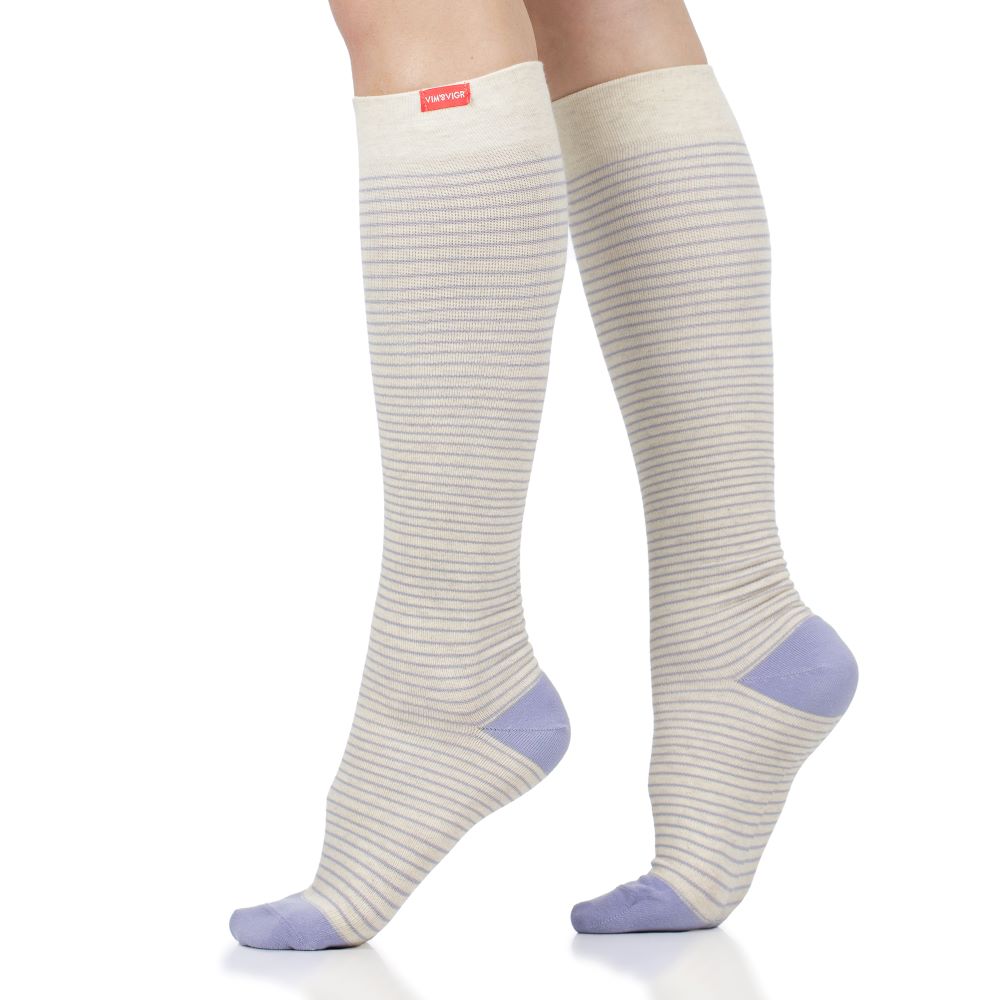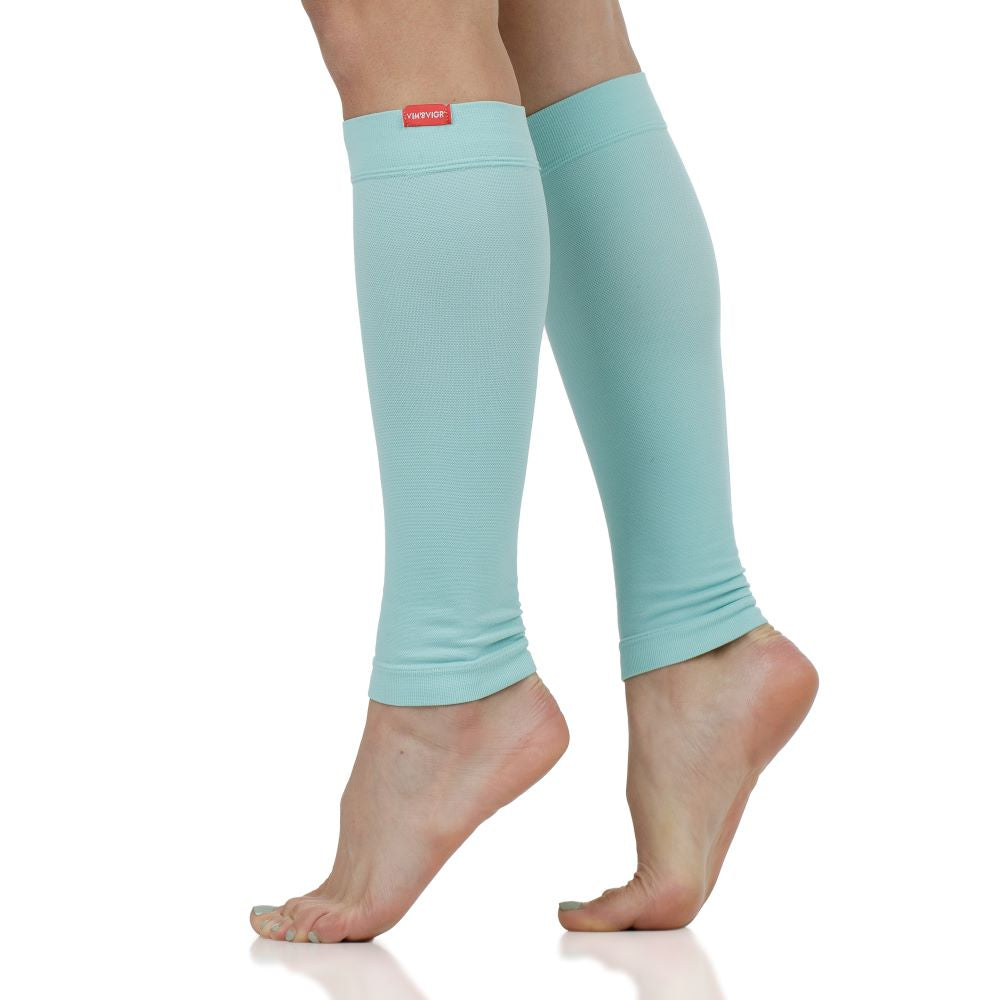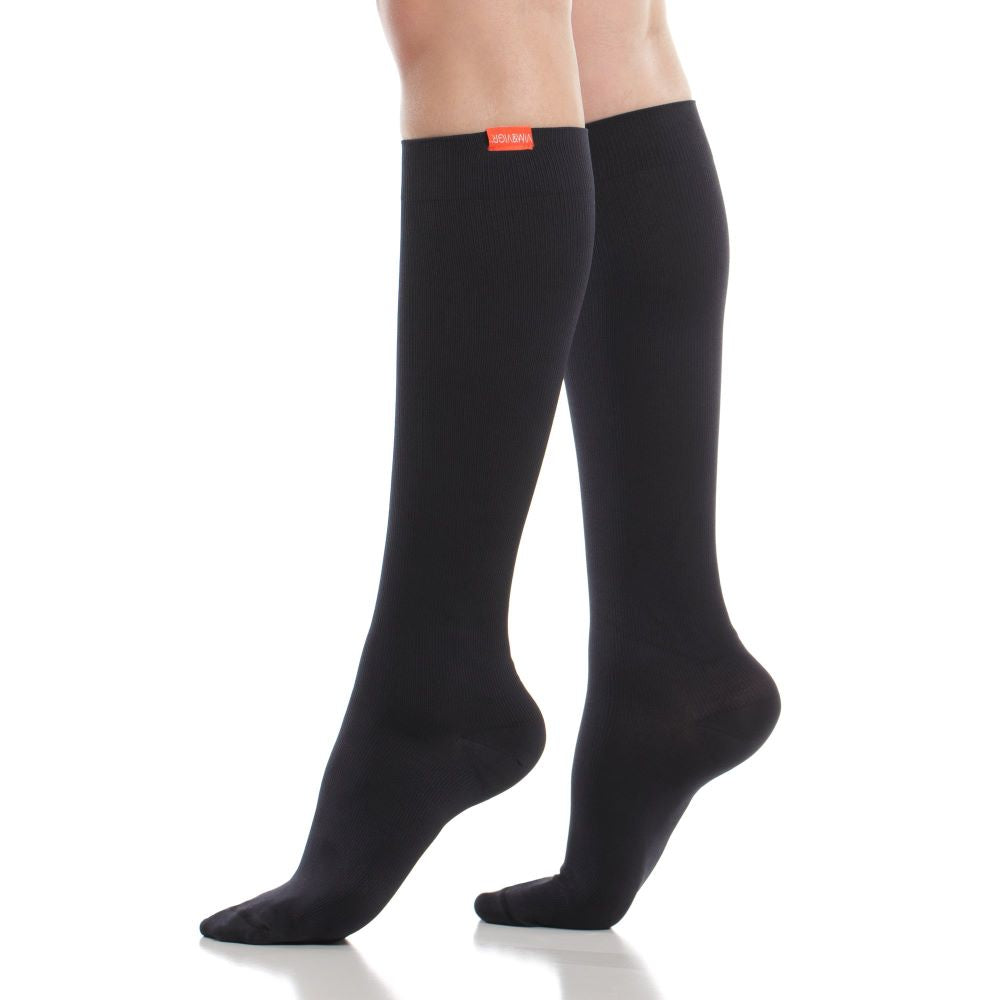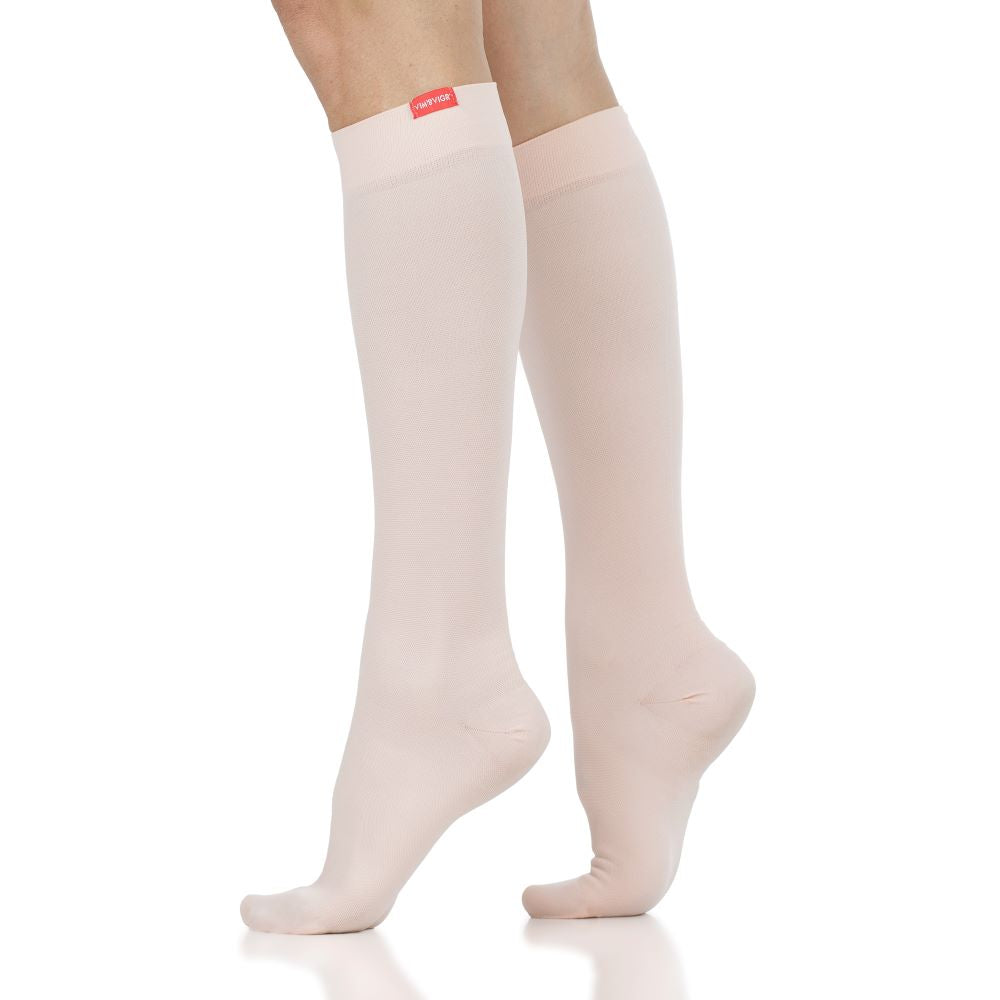Compression Socks for Edema: Why and How to Use Them

What is edema? What causes it?
Edema occurs when small blood vessels called capillaries in the body leak fluid. This fluid leaks into surrounding tissue and saturates it, causing swelling and discomfort. This leaking can have many causes, but mainly putting strain and being on your feet all day can inflame the capillaries. Symptoms of edema are as follows, swelling or puffiness of the tissue directly under your skin, especially in your legs or arms, stretched or shiny skin, skin that retains a mark after being pressed, increased abdominal size.
In many cases, this swelling can happen around the ankles after sitting or standing for too long. Edema can be felt in the hands, legs, ankles, arms, and feet typically, which is why compression socks are recommended for Edema.
Most often, leg edema affects those on their feet a lot, or people having travelled on a plane, due to the change in air pressure and lack of movement for a prolonged period of time. It can also come about when you’re pregnant or as a side-effect of pre-menstrual syndrome. Additionally, too much salty food can cause water retention, eventually leading to leg edema.
Edema oftentimes happens in the workplace when sitting at a desk for long hours or in professions like nursing or waiting tables. Other Causes of edema include pregnancy, salty foods, and the premenstrual cycle.
Medication that can lead to edema includes:
- High blood pressure medications
- Nonsteroidal anti-inflammatory drugs
- Steroid drugs
- Estrogens
- Certain diabetes medications.
Finally, even something so innocuous as ill-fitting shoes can cause your legs to swell, especially after spending a good amount of time in them.
Edema normally goes away on its own, but it can take time and – in the case of pregnancy edema – it can be extremely uncomfortable and persistent. This is why it’s preferable to address it as soon as you can, in ways that fit your lifestyle.
Can compression socks help with edema?
Swollen ankles, heavy feet… the feeling of growing edema is uncomfortable and unwelcome. Whether you’re suffering from pregnancy-induced edema, recovering after a long flight or simply wish to give your swollen legs and feet a rest, combatting these feelings is essential. This is where compression socks for edema can help give your blood circulation a boost and improve your wellbeing significantly.
Compression socks are one of the key ways to fight edema and improve your health and wellbeing. They can be used easily, taken with you on your travels, and come in a wide variety of styles and colors, from patterned to plain and more. Here is why you should use compression socks for leg edema, and our guide on how to make the most of them.
The main situations in which an at-home remedy would be recommended for leg edema are those unrelated to a medical condition. You should also consult with your doctor if you are taking medication or know to have a medical condition, which has leg edema as a side-effect.
If leg swelling has been an issue for you then look no further. In this article, we will talk about compression socks and edema, and how they go together. Want to learn more? Read on!
Stay hydrated
Drinking more water can help alleviate many problems, including edema. Although you might think that getting rid of water in your body is what’s needed, actually your body will hold on to water if it’s dehydrated. To reduce swelling, ensure you’re drinking adequate amounts of water (8-10 glasses every day). Find a water bottle you like, or set goals throughout the day to drink a certain amount of water. Even this small change can make a big difference.
Use compression socks
A good pair of compression socks has been proven to help reduce swelling by applying gentle pressure to your legs and ankles and supporting a good blood flow from your legs to your heart. Through graduated compression, compression socks help support your capillaries, and work existing fluid out of your tissue. They boost circulation, help prevent venous ulcers, and improve lymphatic drainage, among other benefits.
Take Epsom salt baths
Soaking for 15-20 minutes in magnesium sulphate may reduce swelling and inflammation. When Epsom salt is dissolved in water, it releases magnesium and sulfate ions.
The idea is that these particles can be absorbed through your skin, providing you with magnesium and sulfates — which serve important bodily functions.
Elevate your feet
To boost your blood flow, prop your feet on a few cushions and lie down on the sofa for a few minutes. You should also avoid standing for long periods of time. Poor circulation is a main cause of edema, and compression socks can help with that as well. Elevating your feet can work in a pinch.
Stay away from sodium
Reducing your salt intake can be beneficial against leg and overall body swelling. It’s worth taking a second look at packaging and the ingredients in your food, as there may be more sodium in your diet than you imagine.
Read more of our tips about how to combat swelling legs.
How compression socks help with edema
Using compression socks for leg edema is a simple, effective, and portable solution which is also stylish. Its as easy as slipping into comfortable socks that you will want to wear all day long. You will need to choose the best compression socks for edema that meet your particular requirements, like size, fabric, compression level and style. Whether you are looking for men's compression socks for edema, or women's compression socks for edema, here is our advice about picking a compression sock that’s right for you.
Check compression levels
Compression socks have different levels, from 8-15 mmHg up to 40-50 mmHg (measured in a unit of pressure). The lower the compression level, the lighter the effects. Higher compression levels often come at the prescription of a doctor, which is something to keep in mind. For an average person, we recommend 15-20 mmHg. However, if you have moderate edema or are using compression socks for pregnancy edema, we suggest starting with 20-30 mmHg.
Try a few on for comfort
While the feeling of compression you’ll get from a good pair of socks will have a lasting positive benefit and may also make you feel great on the spot, not everyone finds it comfortable to wear compression socks all the time. In fact, you may be wondering how long to wear compression socks for edema specifically.
Doctors may prescribe compression socks to be worn all day, but this truly depends on your level of comfort and activity as well. When not wearing the compression socks, if possible, you should elevate your feet for best results.
Try a few types of compression socks and, once you find a pair you like, experiment with the length of time you keep them on until you find the ideal time for you.
Bottom line, compression socks should be comfortable, your body will tell you when it’s done. We have 4 different fabric types for our compression socks to make them as comfortable as possible for each and every person.
Don’t overlook ease of use
Any type of compression material can be tough to handle and put on easily, so don’t overlook this. Especially when shopping for compression socks for the elderly or disabled. When choosing compression socks for edema, you want to find a pair that’s easy to pull on, rolling them up on your legs. It’s a good idea to double-check a video for tips on how to do this.
It’s also important that they are sized correctly for your leg. At VIM & VIGR, we have 6 unique sizes for compression socks. We measure off of calf circumference and shoe size to ensure that your compression socks fit like a dream. Correct sizing can also ensure that compression socks help edema instead of make you more uncomfortable. If compression socks have bothered you in the past, it may be that they were the wrong size.
The Benefits of Compression Socks for Edema
Our compression socks are made with graduated compression technology. Compression socks work by promoting improved blood flow in your legs. The compression of the socks gently pushes blood flow up the leg, helping to prevent swelling and even blood clots. Not only can compression socks help with edema, but they can also improve circulation, fight varicose veins, and reduce fatigue in your legs at the same time.
Depending on the severity of your edema, you may need to consider different levels of compression in order to treat it. Our socks come in 15-20 mmHg, 20-30 mmHg, and 30-40 mmHg. For mild edema 15-20 mmHg is recommended, for more moderate cases 20-30 mmHg. Typically, 30-40 mmHg comes at the recommendation of a doctor but has been used for Edema.

How Long to Wear Compression Socks for Edema
With compression socks, like many things, consistency pays off. This is why it is important to find compression socks you are comfortable in to treat Edema. This is why our compression socks for Edema come in 4 different fabrics and a variety of sizes to best accommodate your need.
In short, you should wear compression socks as much as possible for Edema, but do not push yourself past the point of comfort! Additionally, you shouldn’t have to compromise style for wellness, which is why we offer our socks in a variety of fun designs and colors so you can find the perfect pair that you won’t mind wearing as much as possible.
Compression socks for pregnancy edema
Pregnancy edema is a widespread phenomenon, and it affects women particularly during the third trimester. This is triggered by accumulated fluid in the body’s tissues, caused during pregnancy by the adrenal glands, which produce more of the hormones that make the body retain fluids (aldosterone and cortisol).
In order to maintain a healthy blood circulation during pregnancy, we recommend staying active and well-nourished, as well as putting your feet up as much as possible. Additionally, wearing compression socks for edema during pregnancy will help reduce not just the swelling, but also aches and pains and the likelihood of developing varicose veins.
Especially when you’re unable to move around or change position, compression socks for pregnancy edema can be a genuine lifesaver.
The best compression socks for edema
Overall, the key reasons we develop leg edema include our diet, our level of fitness and activity, and other influences such as the medication we may be on or important physiological changes such as pregnancy. There may also be times where we’re unable to keep moving or change positions, such as standing around at an event or being crammed into a plane seat on a long-haul flight.
In all these contexts, wearing compression socks for edema will prove a welcome relief from aches, pains, and swelling. Compression socks may also reduce your chances of developing varicose veins. Finally, as there is so much choice in terms of style and color, wearing them can actually be a fashion statement, too. Using compression socks for leg edema is one very effective method to treat and prevent swelling and pain every day while enjoying your lifestyle.
As we mentioned before, we offer our socks in a variety of designs, sizes, fabrics, and compression levels. This makes VIM & VIGR compression socks the best for edema because they can be customized to your need. These aren’t your grandma's compression socks, our socks have stylish designs that will have you wanting to wear them whenever possible. Not to mention our socks were designed with vascular surgeons to help provide the healthiest compression yet.
Our 4 fabric types allow you to choose a sock that fits your lifestyle so you can stay comfortable all day. The fabric types are as follows:
Cotton
- 200 needle-count
- Premium natural cotton fiber
- Multi-dimensional weave for comfort and breathability
- Great for casual wear around the office or workplace
Nylon
- 400 needle-count for strength & flexibility
- Multi-dimensional weave for breathability
- Superior strength and stretch
- Great for a lifestyle full of activity
Moisture Wick Nylon
- 400 needle-count for superior flexibility and comfort
- Draw sweat and moisture off of skin
- Lightweight fabric stretches wide while maintaining strength
Merino Wool
- 200 needle count
-
Sustainably sourced, high-quality, double-covered elastic fibers
-
Naturally breathable, moisture-wicking and odor-fighting
-
Great for hiking and outdoor activity
Whatever fabric you choose, we will have new designs every 6 months and many options to choose from. Wearing compression socks for edema can dramatically improve swelling and your energy after a long day. We hope you enjoy your happy feet!
SHOP OUR COMPRESSION SOCKS



















I hope your socks are available here in Thailand. I am so impressed with the information you have offered. Educating the customer first rather than just touting your product. If more companies had your attitude the world of commerce would be a much healthier place.
Leave a comment